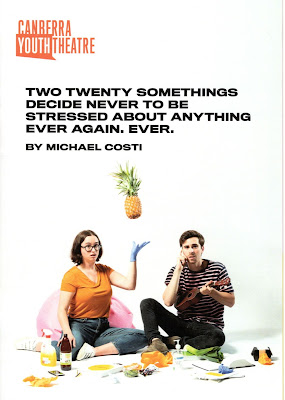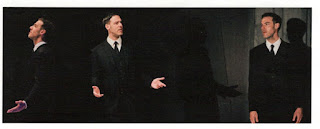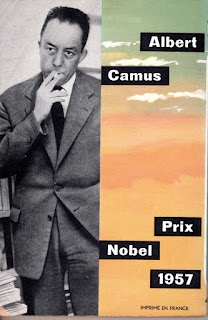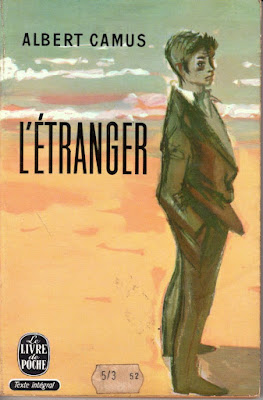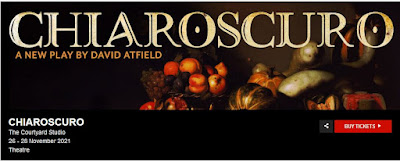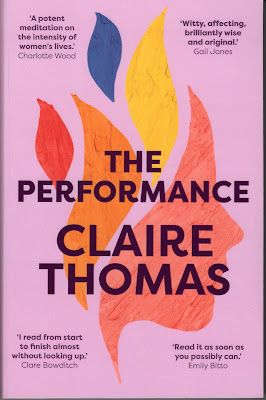New Platform Papers No 1, Currency House, November 2021.
Contact:
Martin Portus Phone 0401 360 806
mportus2@tpg.com.au
Preview by
Frank McKoneThe Platform Papers series published by Currency House, previously directed by
Katharine Brisbane, is taking a new approach, under the new General Editor, theatre director and academic
Julian MeyrickKatharine
provides in her Christmas Greetings an outline of changes, especially
in the status of women, that have taken place over the two decades of
her leadership in setting up Currency House, following her stepping down
as publisher of Currency Press.
Rather than each Platform Paper
being an essay by a single expert contributor, this New Platform Paper
contains five papers, with additional material:
No 1. Imagination, the Arts and Economics Introduction: A Snail May Put His Horns Out,
Harriet Parsons Models, Uncertainty and Imagination in Economics,
Richard Bronk What’s Wrong with Cannibalism?
Jonathan Biggins and
John Quiggin
You Can Sing (Averagely)!
Astrid Jorgensen Afterword: Looking Back and Looking Forwards,
Ian MaxwellRather
than offer a summary of the complex arguments and practical experiences
presented by such a variety show of commentators, here is a selection
of quotes which hopefully will stir your social, political and artistic
interests and knowledge.
Julian Meyrick explains:
The
first issue of the New Platform Papers published in this volume arose
out of an event which will be central to the series from now on, an
annual Authors’ Convention. The Convention itself was the initiative of
my colleague, the new Director of Currency House and Katharine’s
daughter, Harriet Parsons. A brilliant addition to our activities, the
Convention is a two-day public gathering where we invite the authors of
Platform Papers to come together to reflect on a given theme.
Harriet Parsons (Wurundjeri country)
Introduction: A Snail May Put His Horns Out
We
have to decide what changes we are willing to make if we are to plan a
route, not just out of the pandemic, but off the dangerous course we
have been following for the past forty years. The arts may seem an
unlikely point man for this operation. We have become more like a snail
than a butterfly, withdrawn inside the protection of its shell, but as
the eighteenth-century radical Thomas Spence once wrote, ‘a snail may
put his horns out’.
This first volume of the New Platform
Papers is devoted to exploring how our imaginations became captives of
the ‘dismal science’, and the role the arts can play in leading the way
out.
Richard Bronk (United Kingdom)
Models, Uncertainty and Imagination in Economics
The
coordination properties of models and their associated narratives—their
tendency when internalised to frame expectations and influence
behaviour and outcomes—makes them an instrument of corporate or
government power. And this power may—initially at least—be in inverse
proportion to the degree of humility with which the narrative or model
is promulgated.
The poet, Percy Bysshe Shelley, underlined the role of imagination in sympathy and therefore morality in his Defence of Poetry:
A
man, to be greatly good, must imagine intensely and comprehensively; he
must put himself in the place of another and of many others; the pains
and pleasures of his species must become his own. The great instrument
of the moral good is the imagination—and poetry administers to the
effect by acting upon the cause.
Such sympathetic
identification with the plight of others is often seen as the
quintessential opposite of the narrow self-interest of homo economicus.
…we
all have no choice but to imagine the future, interpret the creative
interpretations that others place on their predicaments, and invent new
ways of making sense of our own.
Jonathan Biggins and John Quiggin (Awabakal and Worimi country / Turrbal and Jagera country)
What’s Wrong with Cannibalism?
Jonathan Swift’s essay A Modest Proposal
was prompted by the British national debt crisis of 1729. Having
offered conventional solutions in a number of essays, he turned to
satire in frustration, proposing that landlords eat the children of
their poor tenants:
I grant this food will be somewhat dear, and
therefore very proper for landlords, who, as they have already devoured
most of the parents, seem to have the best title to the children …
Swift’s
A Modest Proposal seems, yes, a ludicrous idea, but then look at
Airbnb, where you monetise your family home. The home was the sacred
hearth of the family. But then someone came up with the idea of selling
part of it to strangers on a nightly basis. We recently toured to Orange
in regional New South Wales. It has 364 Airbnbs, but no-one can rent a
house there.
At an artistic level, much of our cultural policy
is now being dictated by social media platforms, and artists are
increasingly self-censoring. We were recently told not to portray
non-Caucasian characters in the Wharf Revue. We were portraying Xi
Jinping and Kim Jong-un, two of the most powerful people in the world. I
find it extraordinary that satirists are now being told who they can
and can’t offend. I would have thought the point was to offend
everybody.
Harriet Parsons asks: So is the universal basic income the answer for the arts?
JQ:
I’m certainly a proponent of a version of the universal basic income,
which is the level of income guarantee, which would include a basic
living standard for artists engaged in creative work. It differs in the
sense that you don’t give it to Gina Rinehart and try to extract it back
through taxes, you only expand the provision of basic incomes. But that
would provide a basic income to anybody who wanted to apply themselves
to creative work. That is something we could and should do.
Astrid Jorgensen (Turrbal and Jagera country)
You Can Sing (Averagely)!
I
could not wrap my head around the fact that teenagers were spending
every second of their lives consumed by music while simultaneously
proclaiming to hate Music, the subject. They would walk into the
classroom with their favourite singer blasting in their headphones, then
take the headphones out, slump in their chair and despise singing with
me for 50 minutes. I started to worry that I was ruining music-making
for children, which was a heavy burden to bear.
[Astrid left
school teaching to set up the well-known Pub Choir, which in the
pandemic lockdowns became Couch Choir online, attracting participants
from all over the world.]
But there was one thing still
bothering me. None of these choirs reflected me in any way. Each of my
seven choirs were either made up of kids forced to sing by their
parents, or were mostly white, semi-retirees. There is nothing
unpleasant about working with either group. But as a 20-something Asian
woman myself, it was confusing to me that none of my peers wanted to
sing.
So in 2017, after years of friends declining to sing with
me, I wrote a list. On it, I put every excuse I’d ever heard about what
stopped somebody from joining a choir:
Auditions
Time commitment
Having to compete/perform
Reading sheet music
Unfamiliar repertoire
General choir lameness
Having a bad singing voice.
I determined to solve all of these roadblocks. Thus, Pub Choir was born.
Not
always in a pub, the trademarked name, Pub Choir, describes my musical
act. It’s a ticketed show during which I transform an audience—any
audience—into a functional choir.
I believe that Pub Choir
gives people the opportunity to embrace and value mediocrity and truly,
madly, deeply embrace their averageness. There is a freedom in a crowd
where you are genuinely unimportant. Nobody believes that they have
become a better singer at Pub Choir. They just feel less afraid to share
whatever horrible voice they have. If one person forgets what to sing,
someone nearby will remember. Some people sing flat, some sing sharp,
some sing too early, some too late and the overall effect is a rich,
full, electrifying average. Our audiences reclaim music-making back into
their lives, realising that singing belonged to them all along.
The diversity within Couch Choir
participants was remarkable. In one song we had 5,000 participants from
45 countries. We received submissions from places we had never
considered visiting, like Kazakhstan and Norway. People sent videos from
their farms, their wheelchairs, from houseboats, using sign language.
They were younger, older, more colourful. Couch Choir was the
distillation of what I had always hoped Pub Choir would be: regular,
diverse people feeling personally empowered to contribute to the whole.
Sure,
it’s not peer-reviewed research, it’s just 613 people who chose to
participate. But when 100 per cent of them self-report that their mental
health is improved by joining in, it’s worth taking note. Singing—even
online—made them feel happier, more connected and more hopeful. And they
thought it was an experience worth fighting for. Art has always been
more than just entertainment or a distraction. Art can heal us.
Ian Maxwell (Cadigal and Darramuragal country)
Afterword: Looking Back and Looking Forwards
Exhaustion,
then, is integral to the [arts] field at the best of times. In the
context of the acute crisis of the current Covid-19 epidemic, the arts
eat their young…. [leading to] three questions, which were put to the
Convention for further discussion. Four key themes emerged. First, the
proposition that art and culture are fundamental to the sustainability
of society; second, that those engaged in the fields of art and culture
do not have the capital to support them; third, that the arts are
exhausted; and fourth, that its professionals have been pitted against
each other in the competition for resources, with the result that the
sector has become fragmented and unable to advocate for its interests as
a whole.
Ambiguity is the strength of art, as well as its
weakness. Historically—indeed from Plato onwards—the protean,
make-believe, liminal nature of theatre—and the recent genres that take
up the even more equivocal trope of ‘performance’—has generated profound
anxiety and moral panics.
Our challenge is to resist
reprising old arguments that belong to the past, and instead peer
through the lens of new experiences with the eye of imagination. That, I
hope, is the project Currency House has set before us, and towards
which the inaugural Convention of 2021 has made the critical first step.
For interviews, review or purchase, please contact Martin Portus.
© Frank McKone, Canberra







